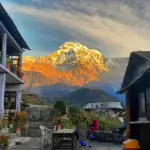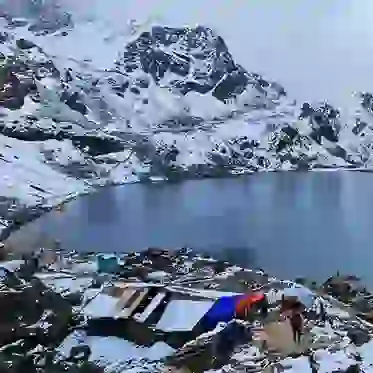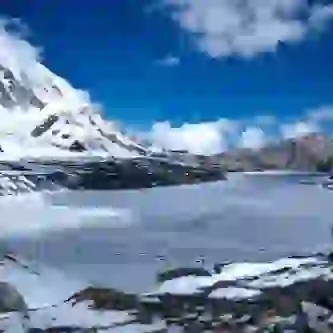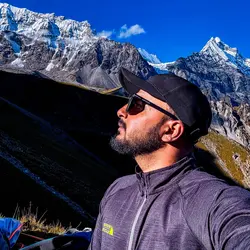
Nepal has always been claiming the attention of bird lovers worldwide due to its unparalleled avian treasure in terms of landscapes and cultural phenomena.
Housing over 900 species of birds, this country is an avian haven and a paradise for every Featherbrain.
From the graceful Himalayan monals to the exotic Nepal Wren-Babbler, Nepal offers quite a chunk of wonders in avifaunal that will undoubtedly leave any birdwatcher bemused. It will be fascinating behaviour that you will see at every step, leaving you awestruck by the intricacy of nature.
It's not just the birds; many other things about Nepal will also make you head over heels for this place. Here, you can also get into the culture, dip deep into ancient history, and much more to make your trip time memorable.
A Haven for Birdwatchers: Bird Watching in Nepal – Top 10 Birds One Must See and Their Places.
The birds of Nepal have turned into an orchestra of colour and song, having an avian opera filling the sky right above. The seeing of these winged wonders has seen one enter paradise for bird lovers through realms of feathered beauty that captured hearts and souls alike.
Top 10 Birds in Nepal
- Northern Eagle Owl
- Maroon Oriole
- The Long-tailed Mountain Thrush
- Chestnut-headed Bee-Eater
- Blue Indian Roller
- The Spiny Babbler
- Tibetan Siskin
- Stork-billed Kingfishers
- The Egyptian Vulture
- Danphe
Discover the Endangered animal and bird species in Nepal with Hop Nepal Jungle Safar Packages
Let us take a trip to explore the top 10 must-see birds of Nepal and uncover the hidden gems that support these magnificent creatures. Every bird has its perch in the scheme of things, from the sharp glance and thick claws of the Northern Eagle Owl to the lovely rusty maroon body and streaky brown hues of the Maroon Oriole and their melodious trill.
The Long-tailed Mountain Thrush sits high on a lofty rock, eying the plains around with jealous vigilance; the Chestnut-headed Bee-Eater skims low and then shoots up to the skies with the insects it has hawked; the Blue Indian Roller whirls around in gyrations and fly-pasts that dazzle.
The Spiny Babbler—the most camouflage champion you could think of—can vanish into the undergrowth. With great zeal and popping out from one tree to another, the Tibetan Siskin fills the air with its sounds. Diving at full throttle into the water is just how Stork-billed Kingfishers emerge with the prey dangling at the tip of their beak.
The Egyptian Vulture is no doubt one of the finest species of birds that spread their wings in the atmosphere endlessly across a landscape. It flies, symbolizing freedom and power, with each side using keen vision to scan its following possible action some few meters below the earth's surface.
But how can one spot these elusive creatures, you ask?
Fear not; we have a guide to help you navigate the terrain.
Navigating the Terrain
Each ecosystem is home to unique inhabitants, from the dense virid forests of the Chitwan National Park to the rough mountainous landscape of the Annapurna region.
Simply heeding the call of the birds will make their song swing you over lonely valleys and misty peaks. Listen to the leaves rustling, wings fluttering, and the thrill of a melody that arises and fades into the distance. Finally, spotting that elusive creature, truly breathe in the moment's magic to appreciate how wonderfully nature has put it all together.
In Nepal, birds are not just another creation of the sky but an ambassador of the land and harbinger of a pretty yet mysterious world. The birds remind us of the means of power, the freedom that comes with flight, and the open sky with no boundaries in the wild world.
Birding in Nepal: Best Seasons and Weather Conditions

Once you travel through the dense forests and the curvy paths of Nepal, those roads and paths seem farther. You feel the crisp mountain air caressing your face. Leaves are rustling; trickling has become an everyday companion, but somehow, you still think that more is yet to come across.
Jaw tensed with excitement and eyes through powerful binoculars; one eagerly sets out to explore the birding world of Nepal.
But before you catch a flight, you must know the best seasons and the weather conditions ideal for birding in Nepal.
September to the beginning of December and late February to early June are the most suitable times for Bird-watching in Nepal. The weather is mostly dry, and the sky is evident in these months; observation of birds becomes more accessible as they flit around from one tree to another.
The climate, however, varies in Nepal, and the place offers excellent birding opportunities any time of the year.
The Himalayas' high altitudes are home to several bird species that can bear the harsh, freezing temperatures at high mountain tops, like the Snow Partridge and the Snow Pigeon.
Here, in these Terai lowlands within the deep subtropical jungles, live birds like the Bengal Florican and the Sarus Crane prosper in the warm, wettish weather.
But as we explore this stunning landscape, we must acknowledge today's climate concerns.
Weather pattern and climate change is a bewildering issue.
Climate change is having ruinous impacts on the habitats and migratory patterns of several species of birds. So, it is essential to save them. Let's move towards eco-friendly steps, support one and all under this cause of sustainable conservation, and bring awareness of how Nepal retains itself as a haven both for birds and bird lovers.
A trip to Nepal is ideal for all categories, whether you are a veteran birder or a newbie explorer. No place can be more appropriate than Nepal, with its beautiful landscapes, varying climate, and live birdlife.
Endangered Rare and Species Of Birds In Nepal
When it rose behind the mountains and into view, one could feel the sharp outline of the beauty amidst these rare endangered bird species against the Nepalese landscape.
Nepal's Bird ecosystem incorporates some of the world's rarest and most endangered species. These bird species in Nepal have been elaborately accounted for by the paper at hand.
Nepal has traversed a long way in the conservation of its rare and endangered avian species. It was in this manner that concern by several programs and individuals saved many bird species from almost successful conservation. However, much work remains, with the battle far from over.
Rare and Endangered Species Of Birds Sighted and Conserved in Nepal

In the picture: Sarus Crane
One of the rare species of birds found in Nepal is the Black Stork. This is one of the medium-sized storks that prefer habitats near freshwater bodies.
Another common stork found in Nepal is the White Stork, which is white with a red beak.
The Sarus Crane is the tallest flying bird in the world and has otherwise been a culturally neutral creature in Nepalese culture. They inhabit wetland areas and are characterized by their distinctive, loud, trumpeting calls.
The Cheer Pheasant is a weird bird species, startups inhabiting exclusively the western Himalayas. Its piercing voice is the echo of the mountain ranges and can be taken as a very valid symbol of the wild Himalayas.
The Himalayan Monal, or Impeyan Pheasant, is a mesmerizingly beautiful bird species that inhabits the high-gradient peaks of Nepal. The male is recognized for its plumage and is a favourite among bird watchers.
The Satyr Tragopan is a rare species of bird found in the Eastern Himalayas. They are famous for the two horn-like things projecting from the head and the red skin surrounding the eyes.
The critically endangered bird species of the two are the Bengal Florican and the Lesser Florican. The female Bengal Florican can be found in Nepal's grasslands, and the male is characterized by unique courtship behaviour. The last is a migratory bird that lives in Nepal's southern plains.
The Great Hornbill is a large bird species found in the tropical forests of Nepal. It has a vast, prevalent beak and is respected in lots of cultures due to its spiritual importance.
Though, at least in Nepal, rare and endangered, these sorts of rare birds can be sighted, and, due to their conservation, care should be taken even in their habitat.
Bird Photography Tips and Techniques in Nepal

The resplendently colourful plumage, flitting in and out through the foliage, leaves bird lovers and photographers in a trance. Nepal is a haven for avian delights to those who like clicking moments into their lenses.
It Is Bird Watching: A Short Introspection.
Bird photography requires patience, skill, and a keen eye for details. With its vast diversity in landscape numbers and unique bird species, Nepal is becoming an exciting place for many photographers to capture this perfect shot. In this paper, I will summarize the fundamental suggestions and techniques for effectively capturing birds on film in Nepal, with information on what equipment to use and how to go about it.
The correct equipment will need to be invested first to capture bird photographs. The right camera adjusted with zoom allows you to take your shots if a long lens is used to stabilize them on a tripod.
A high shutter speed is also essential for freezing the movement with fast animals. Investing in a good camouflage outfit or hide would also do wonders in getting into close ties with the birds without scaring them away.
Lens Viewing: A Photographic Sensation Of Nepal
Now that you are equipped, get out to the birding hotspots of Nepal. The rich forests in Chitwan National Park and the wetlands of Koshi Tappu Wildlife Reserve are ideal places for observing different species of birds.
Spot the iconic Himalayan Monal, the elusive Satyr Tragopan, and the hospitable White Stork.
Now, several bird-trapping tricks can be used to make some fantastic captures related to photography techniques.
First, be light-sensitive and shadow-sensitive for the light that falls on your frame and background. A clean, clutterless background makes the subject pop out, while under- or overexposure can ruin a potentially great picture.
Another important aspect is that eyes should be focused on, for it gives depth to the photos and character, as it pulls one right into a bird's world.
Also, shooting the bird while it is moving in flight or during feeding can add a dynamic element to your shots.
Birds, Culture, and Adventure: A Complete Guide to Bird Watching in Nepal
If you are a birding enthusiast, then seize the opportunity to share in other unique and memorable adventures with a journey to Nepal—full of immensely enthralling and really vivid birdlife.
From the thriving city of Kathmandu to the desolate wilderness of Bardia National Park, this birding tour across Nepal covers single trails through some of the most astonishing landscapes in the world.
Bird Nirvana Scouting in Nepal: An Informative Itinerary
We will also start our trip in Kathmandu, a vibrant city where people can acclimate to high altitudes and immerse themselves in the rich culture of this Himalayan region.
Take a day or two around some of the oldest temples in town and in its tangle of marketplaces before heading south into the lush, forested reserve and UNESCO World Heritage Site at Chitwan National Park.
Here, you will find some of the rare and endangered birds like the Bengal Florican—awesomely beautiful, majestic Sarus Crane—and the uniquely elusive Black Stork.
Then on to a lowland Terai region and a visit to the remote wilderness area of Bardia National Park. This thickly forested, uninhabited wilderness abounds wildlife, a perfect place from where we can seek out the elusive Satyr Tragopan and a magnificent Great horn bill.
As we go deeper into the heart of Nepal, we make our way up to the mountains of the Annapurna and Everest ranges.
Here, you will have a chance to see the magnificent Himalayan Monal, a bird that shows off impeccably while the sun makes its hues shine like a jewel. We will also glance at the beautiful White Stork and colourful Cheer Pheasant.
But our trip is not only about birding. We'll easily be able to be acquainted with the landscape and visit the most remote villages.
You will be acquainted with their customs and traditions, followed by relishing some scrumptious delicacies like momos.
In most cases, you will be hosted by experienced birding guides who are always ready to help you identify and take pictures of whatever kind of bird species.
This is besides sharing their knowledge of the ecology and history of the region, which leads to a clearer picture of the interconnection between the birds and their habitat.
The pleasure of a bird-watching trip across Nepal will let you view some of the most beautiful and rare birds in the world amidst this enchanting treasure trove of rich cultural heritage and a natural palette of pleasing beauty in its lap.
It is a quest of discovery and adventure, unveiling hidden treasures, and it serves as an opportunity towards holding dear the memories garnered. So let's go and experience Nepal like never before!
Birding Hot Spots in Nepal: Where to Find Maximum Diversity.
It is, therefore, a paradise for bird watchers, with its diverse range of avifauna species sprinkled across varied landscapes. We'll explore some top birding hotspots in Nepal and note the unique species at each location. You can Book now and visit Nepal to explore the endangered species of birds in Nepal with Hop Nepal, We provide tour and travel package of the below given hotspots.
Located next to the country's hub, Kathmandu, and only a few hours' drive away, Shivapuri National Park is extremely popular among birdwatchers.
This is home to over 300 species of birds, out of which the Rufous-gorged Flycatcher, Ultramarine Flycatcher, and the Blue-throated Barbet have their dwelling.
Nagarjun National Park is located only a few kilometres west of Kathmandu and is another destination for nature and bird lovers.
The park is equally essential for its mixed oaks and pine forests that provide habitat to a number of birds, including the Spiny Babbler, Hill Partridge, and Rusty-cheeked Scimitar Babbler.
Phulchoki and Godavari will make up a great trip while birding into forests at the edges of Kathmandu.
Phulchoki is the highest peak on the southern rim of the Kathmandu Valley and hosts the rare beauty of Monal in the Himalayas.
Godavari, which lies at the foot of the Phulchoki Hill, harbours salutations to the White-tailed Nuthatch, Spotted Nutcracker, and Fire-capped Tit, among others.
Chitwan National Park is located in Lowland Terai, which lies in south-central Nepal. It is also known as another site that UNESCO has declared for conservation.
More than 500 different varieties of avian species have been playing host in the park, including Bengal Florican and Sarus Crane to Black Stork.
Bardiya National Park is the place to be for a truly remote and pristine wilderness experience.
It lies extreme to the west of Nepal, housing over 400 species of birds, ranging from the Great Hornbill to the Satyr Tragopan and the Jungle Owlet.
Phewa Taal(Lake) is the most famous lake in the middle of Pokhara. The surrounding lush green hills provide a beautiful setting for bird enthusiasts.
In this lake, one can find most water birds like Little Grebe, Common Moorhen, and Indian Cormorant. If luck favours, perhaps a great Great Crested Grebe—a winter migrant to the lake—can be identified.
Other common lakeside woodland birds are grey treepie, blue whistling thrush, and verditer flycatcher. Naturally, since it's a woodland bird, the lake area and its shores provide shelter to the rare and even more elusive White-tailed Rubythroat, which turns out to be a winter visitor to Nepal.
Birds Which Are Commonly Found in Nepal
Besides these top birding spots, Nepal has several bird species' habitats. Here are some of the most commonly seen birds in Nepal and their prominent features
· Daurian redstart Phoenicurus aureus – A relatively small, colourful bird easy to see from the bright orange-red tail found all over Nepal in the forest and with open faces.
Eastern spot-billed duck, Anas zonorhyncha: This duck is a typical winter visitor to Nepal and is found in wetlands and paddy fields. It has a yellow spot on its bill.
· Grey heron (Ardea cinerea): Found in the waterlands and along the banks of rivers and lakes in most parts of Nepal. Mantle grey; bill long and pointed.
·Indian Peafowl (Pavo cristatus): The national bird of India is also a common bird seen frequently in Nepal, which has very impressive multi-colourful plumage and is seen mainly in open areas and forest edges.
· Oriental Magpie-Robin (Copsychus saularis) - It is a reasonably common, small, very melodious bird found throughout the urban gardens and parks of Nepal, having colouration of black and white in a beautiful pattern.
· Red-Ventured Black BulBul (Pycnonotus cafer) – A tiny bird with a red vent can be seen in the gardens and forests of Nepal—a very musical-sounding bird with calls and spotting movements in the form of small flocks.
· White-throated Kingfisher (Halcyon smyrnensis): A handsome, more significant than the average colourful bird almost spread out all over the country near water bodies. Blue and white and makes a loud, shrill call.
White Wagtail (Motacilla alba): This small, sinewy bird can be seen in the wetlands and beside water systems across Nepal. Instantly recognizable by its constantly wagging tail, white in color.
· Zebra Dove (Geopelia striata) – Small, a dove found in gardens and open surroundings throughout Nepal. The plumage of this dove is black and white with stripes, making it different; likewise, the sound of this dove is melodious. Rock Pigeon (Columba livia): Found in most built-up city areas of Nepal. Gray all over, an iridescent sheen in the neck is visible.
Explore the Wonder and Magic of Avifauna in Nepal.
The birding tour of Nepal is over now, and it has been memorable. It leaves an indelible mark on our hearts—the beauty of this country, its people, and birds. From the decorated streets of Kathmandu to spending time in the wilds of Bardia National Park, it seemed that Nepal's diversity was never-ending. We encountered some of the world's most elusive and magnificent birds, from the colourful Himalayan Monal builds to the majestic Sarus Crane. And in each place, we revelled in the richness of culture and natural beauty that Nepal is home to. But our journey doesn't have to end here. There is much more Nepal has to offer for those willing to brave adventure and discovery—trekking in the Annapurna region, white-water rafting in the Himalayas, uncovering ancient shrines and monasteries, or anything in between. Therefore, if you are ready to be a part of one of the most incredible journeys humanly possible, come to Nepal and let its beauty and diversity enthuse your breath. And who knows—you would cross paths with one crazy bird or the other.

















